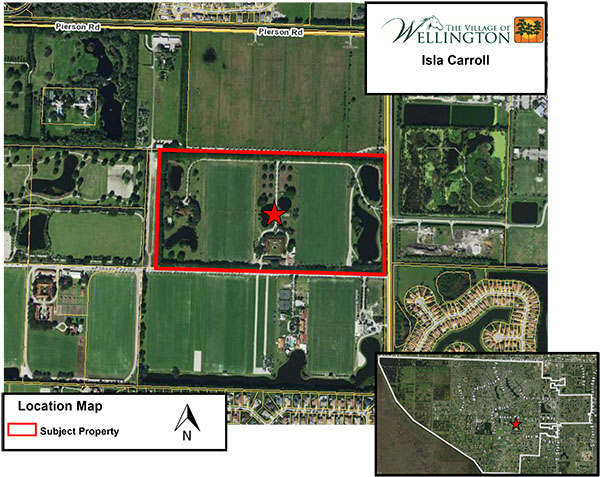A plan to put 40 homes on 79 acres in Wellington’s equestrian area, 35 of them clustered on as little as a third of an acre each, ran into enough pointed questions from members of Wellington’s Planning, Zoning & Adjustment Board last week that it prompted the developers to ask to postpone the board’s vote for roughly a month.
Meeting Wednesday, Jan. 15, the board agreed by a 5-2 vote to delay consideration of the Isla Carroll project, with PZA Board Chair John Bowers and Vice Chair Michael Drahos dissenting.
“I think the project looks beautiful,” Bowers said. “I have concerns related to the site, because of it being in such a sensitive area.”
The board’s next scheduled meeting is Wednesday, Feb. 19. The postponement followed a 7-0 vote opposing the project from the village’s Equestrian Preserve Committee a week earlier. Regardless of advisory board votes, the Wellington Village Council will have the final say.
The project is turning into the latest flashpoint over what development should be allowed in Wellington’s economically vital horse country. It follows council approval of the Wellington Lifestyle Partners development plan last year that removed 96 acres of land from the Equestrian Preserve Area for the first time in village history to build a luxury golf community. Developers said it was justified by a consolidated and expanded showgrounds area, part of a larger strategy to build 203 luxury residences and a commercial main street with a hotel, shops, offices and restaurants.
With Isla Carroll, the idea is an equestrian-themed club community, but most lots won’t be big enough to stable horses at the site off 120th Avenue South, about 1,350 feet south of its intersection with Pierson Road, and just north of the National Polo Center. Five lots will be at least 1.5 acres, big enough for a stable but short of the traditional two-acre standard. Residents and up to a total of 300 club members would have access to a community barn, 24 stalls, riding rings and other amenities, officials said.
Board members grappled with questions such as whether allowing clustered homes on as small as a third of an acre each effectively removes them forever from the conventional equestrian-area model of multi-acre lots. In contrast, having 40 two-acre lots does not guarantee they are all put to equestrian use, but preserves that possibility for future buyers.
“We remove usable equestrian acreage to be able to make an equestrian-themed development work, but I think that does sacrifice a lot,” Bowers said.
Developers said it creates an incubator for prosperous families who can introduce their members to the equestrian world. Most probably would not be full-time residents.
“If you look across our projects, they are largely second and third homes for the homeowner,” said Ed Divita, a partner with Discovery Land Co., part of the development team that operates dozens of communities worldwide focused on outdoor recreation from skiing to golf to seafaring. “It would be wrong not to recognize the seasonality of Wellington as it is.”
The club would operate year-round but adjust staffing and offerings such as dining in the off-season, he said.
What is being called a “sports complex” would sit on almost 112,000 square feet, featuring a gym, retail and food services, a business center, pools, racquet sports and a kids’ club.
Homeowners on the five larger lots have room for their own stabling if they choose, and the other 35 property owners could request to stable a horse on site if there is space in the communal stalls, project officials said. Discovery Land Co. would own the club grounds and horses available there, and the site could also feature rescue work with older horses, representatives said.
“Our proposal respects the existing 40-home density at Isla Carroll while embracing a more visionary approach,” said Tom Lucid, senior vice president of development at McCourt Partners. “Rather than fragmenting the property into conventional two-acre lots, where no equestrian facilities are required to be built, and which offers no assurances of fostering connections within the equestrian community, we have envisioned a 30-acre equestrian club as the heart of our development.”
The McCourt firm was founded by Frank McCourt, former Los Angeles Dodgers owner, billionaire, Wellington property owner and equestrian aficionado.
Bridle trails running throughout the property and shared club amenities help tie the community together in a way that emphasizes the connection with horses, the builders explained.
The applicants volunteered to agree to conditions to guard against worries that houses will get built as amenities lag or never quite happen. One of these possibilities was to complete the entire equestrian center, in some cases restoring or renovating an existing barn and other structures on the site, before more than 10 homes can be granted certification of occupancy, said Seth Behn, a shareholder with Lewis Longman Walker, a law firm working with the applicants.
Behn later proposed a delay as questions from board members focused on what guarantees the applicants could provide that they would operate the club for an extended amount of time — say, 10 years or longer.
Discussion turned to cases in Wellington and elsewhere where a community barn or other promised attractions did not materialize or endure, or came under control of a homeowners’ association that did not always reach consensus on how to proceed.
The proposal does not formally take land out of the village’s Equestrian Preserve Area, but it risks achieving a similar effect, speakers during public comment said.
Equestrian Dr. Kristy Lund, a former member of the board, said that smaller lots are basically removing that land from the traditional horse-farm universe going forward. “This is like taking land out of the equestrian preserve,” she said.
Resident Jennifer Preletz spoke in support. She said she thinks the emphasis on experiences with families around horses is a good thing, and it’s overblown to say these residents will be cloistered at their club and not interact with other people and businesses in the village. “It’s a perfect fit for Wellington, in my opinion,” she said.
Drahos, a former Wellington Village Council member, sought specific assurances that Discovery would operate the club for a given period of time. He said he did not hear that.
“When we’re being asked to take this remarkable step, there should be remarkable evidence to assure what we are doing is worth the sacrifice,” Drahos said. “I think you all fell short of that tonight.”
Fellow PZA Board Member Tatiana Yaques raised similar concerns. The concept that Wellington’s equestrian area “needs a community barn to incubate equestrian sports and a passion for equestrian, I think that’s a fallacy,” she said, adding that Wellington already serves as its own incubator in this respect.
PZA Board Member Elizabeth Mariaca wondered if conditions could be considered instead of proceeding to an immediate vote.
“I don’t think we should throw this away and say this can’t go forward,” she said.
Behn said, “Thank you for your efforts and focus on this application. We’ll look forward to bringing something back to you.”
In other action, the board unanimously approved zoning and master-plan amendments that make possible 220 multi-family residential units on 10 acres near the Mall at Wellington Green that were the subject of a settlement between the village and the original mall developers last year.
The Axis 2 project sits south of Forest Hill Blvd. near the Hampton Inn hotel, northwest of the core mall area. Applicants said the plan will include four six-story apartment buildings, a clubhouse, dog park, pool, grilling and other recreational areas.








